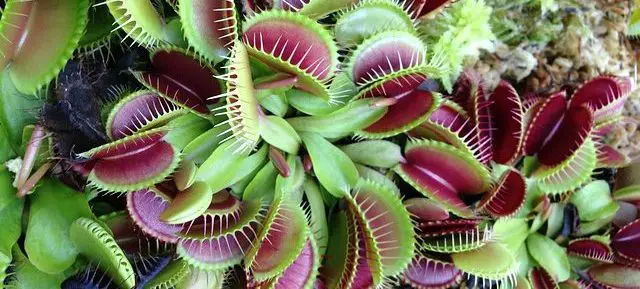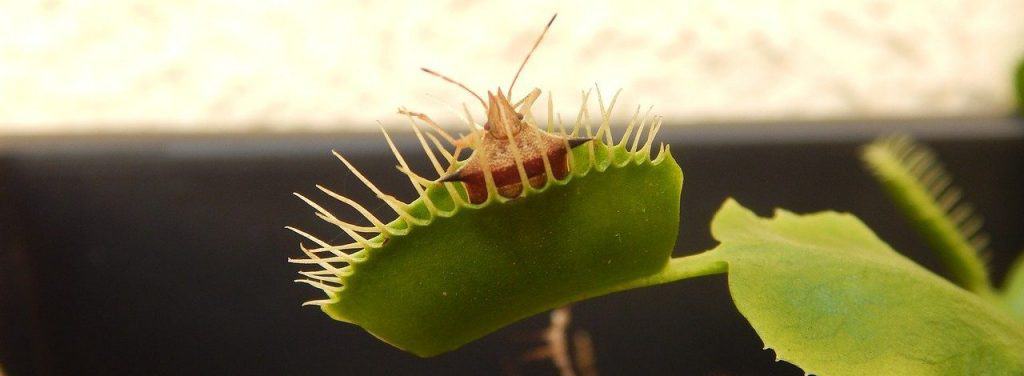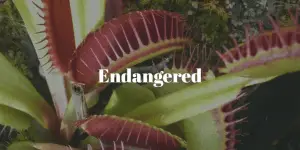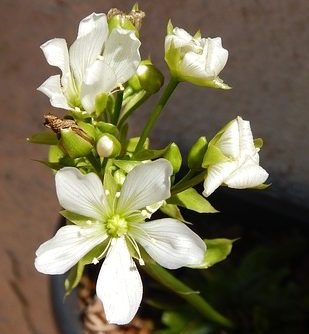Venus flytraps are fascinating plants that spark the curiosity of kids and adults alike. There is so much to learn about these pants, from its habitat to its evolutionary origin. This article explores 11 fun Venus flytrap facts for kids (or adults). We hope you enjoy learning about Venus flytraps!
11 Venus Flytrap Facts for Kids
1.-Venus flytraps are carnivorous plants, and their leaves are unique
Venus flytraps are the most famous carnivorous plant. They are cataloged as carnivorous plants because they eat meat, and their diet consists mostly of insects.
The image below shows a few Venus flytrap plants with several branches. Each of their branches has two leaves, which form a trap. The traps produce sweet nectar to lure insects. The reddish interior of the trap contains the nectar. Also, there are sensory hairs inside the trap that detect movement. When a bug enters a trap, it will very likely hit the sensory hairs a few times. Then, the trap will close rapidly and capture its prey.

2.- Venus flytraps have a diverse diet
The name “Venus flytrap” can be misleading. It seems to suggest that Venus flytraps feed themselves with flies exclusively. Yet, Venus flytraps eat a variety of bugs, such as ants, flies, spiders, beetles, and slugs. Also, Venus flytraps can eat small rodents, lizards, or frogs (if they can catch them!).

3.- Their digestion takes a long time
Once a Venus flytrap has caught an insect in its trap, it will start the digestion process. The leaves produce enzymes that decompose the victim. As the prey decomposes, the plant absorbs its nutrients. The Venus flytrap digestion process is unique, but it is not fast. It takes one to two weeks for a plant to consume one insect entirely. Nevertheless, Venus flytraps are in no rush; they can live for several months without catching a meal.
4.-Venus flytraps are native to South Carolina and North Carolina, in the United States
Venus flytraps are native to the US east coast, specifically to the states of North and South Carolina. Because Venus flytraps are very popular plants, people grow them and cultivate them all over the world. However, the plants are only native to the Carolinas. There, Venus flytraps grow with an abundance of sunlight in very humid terrain, which in most cases, lacks nutrients.
5.- Venus flytraps are an endangered species
Unfortunately, Venus flytraps are endangered. Their original habitat has been changing due to an increase in urbanization and agricultural development.
Venus flytraps are fascinating plants, and people like buying them. It is ok to buy Venus flytraps from responsible growers. However, some irresponsible vendors extract Venus flytraps directly from their natural habitat. This process is called poaching, and it is illegal because it threatens the survival of an endangered species[3] .
.

If you would like to grow a Venus flytrap, you have a few options. You can grow them from seeds or buy them from environmentally conscious sources. But, do not collect Venus flytraps from the wild; you would be hurting the species.
6.- Venus flytraps are the State Carnivorous Plant of North Carolina
In 2005, the Venus flytrap became the State Carnivorous plant in North Carolina[1 ]. It is not common for a state to declare a State Carnivorous Plant; actually, North Carolina was the first and only one so far. We hope this initiative to make the Venus flytrap a state symbol will create consciousness between people and promote the conservation of this marvelous at-risk species.
]. It is not common for a state to declare a State Carnivorous Plant; actually, North Carolina was the first and only one so far. We hope this initiative to make the Venus flytrap a state symbol will create consciousness between people and promote the conservation of this marvelous at-risk species.
7.- Venus flytraps have flowers
 Just like most plants, Venus flytraps flower in the spring. Their flowers grow in bundles, and they are white.
Just like most plants, Venus flytraps flower in the spring. Their flowers grow in bundles, and they are white.
The flowers grow tall. A lot taller than the traps. Then, pollinators such as bees and butterflies can collect nectar from the flowers without getting caught by the traps.
8.- Venus flytraps go dormant during the winter
During late fall and winter, they go dormant. The dormancy period of Venus flytraps is similar to hibernation for animals. When fall is coming to an end and temperatures start to drop, Venus flytraps go dormant. Their leaves wither, and the plant reduces in size. The physical changes due to dormancy are very pronounced. Some Venus flytrap owners might even think their plant is dying. However, a few months later, the plant will finish dormancy and flourish in the spring.
9.- Lots of Venus flytraps references in movies and video games
Venus flytraps are commonly featured in movies and video games. You might remember the Piranha Plant in Mario Bros video games. They have a high resemblance to carnivorous plants, especially to Venus flytraps. Also, there are a few Pokemon that look like carnivorous plants: Carnivine and Victreebel.
The 2008 movie “Journey to the Center of the Earth” also features Venus flytraps. They used the Venus flytrap for inspiration, but they created an exaggerated human-size version.

10.- Charles Darwin was fascinated with Venus flytraps
Charles Darwin was an English scientist in the 1800s. He made crucial contributions to the fields of biology and geology. He was best known for his theory of evolution by Natural Selection. Darwin referred to Venus flytraps as “the most wonderful plant in the world.” Considering Darwin studied thousands of different plants and animals, he must have really been impressed by Venus flytraps. [2 ]
]
11.- Venus flytraps can’t hurt humans
Venus flytraps are safe for humans. Their traps might seem scary when looked at closely, but they are not strong or big enough to hurt you if you stick your finger inside one. But, try to avoid triggering the traps with your fingers. Venus flytraps weaken every tie they use energy, and controlling those traps takes significant amounts of energy. Instead, consider feeding a Venus flytrap and watching the traps get to work!
We hope you enjoyed these 11 Venus flytrap facts for kids! Feel free to browse around our site for more information on Venus flytraps. And for more facts on Venus fly traps, check out this extended list.
Sources:
- [1] https://statesymbolsusa.org/symbol-official-item/north-carolina/state-plant/venus-flytrap

- [2] https://www.britannica.com/biography/Charles-Darwin

- [3]https://therevelator.org/venus-flytrap-poaching/

Are you interested in feeding a Venus flytrap? It is amusing! Here is a guide on how to feed a Venus flytrap:
